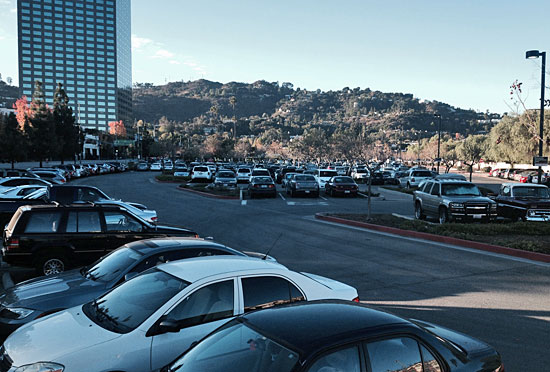This parking lot’s no paradise
December 6, 2013
On a chilly weekday morning, after squeezing his truck into the last available spot in the main lot at the Universal City/Studio City subway station, Mario Beltran summed up the parking situation in two words: “It’s terrible.”
“If you’re not here by 8 o’clock, you’re out of luck,” said Beltran, 36, as he hurried to catch a train to downtown L.A.
Beltran was lucky that day. According to some of his fellow commuters, lots are often filled up by 7:30 a.m. or even earlier at both of the Valley’s Red Line stations, in Universal City and in North Hollywood.
Some, like 25-year-old Joanna Sintek, who commutes from Burbank to the Natural History Museum in Exposition Park, have had to learn that the hard way.
“I would show up and get grumpy and have nowhere to park,” Sintek said. “I’d just drive instead.”
Since then, Sintek has discovered an L.A. County-owned overflow lot on Ventura Boulevard, but she said it’s a long haul from that lot to the station entrance, and it comes with an uncomfortable passage through a poorly-lit pedestrian tunnel beneath the 101 Freeway.
Parking can be tough in many parts of the city, but the two San Fernando Valley subway stations get extra pressure because they serve as the main transit gateways to Hollywood and downtown L.A.
Help may be on the way. On December 5, Metro’s Board of Directors unanimously passed a motion by L.A. City Councilman Paul Krekorian, County Supervisor Zev Yaroslavsky and Mayor Eric Garcetti, instructing the agency to investigate possible fixes, such as additional lots, parking garages or a joint development project to increase parking. The motion also directs staff to report back on bicycle and pedestrian improvements that could be made to the stations and surrounding areas.
There are currently 951 spaces at North Hollywood—300 of which are reserved at a cost of $39 per month. At Universal, there are 661 spaces, 140 of which are reserved. The County-owned satellite lot has 160 more spaces.
Robin Blair, Metro’s director of planning, said the agency already is in the process of installing a lot in North Hollywood that will accommodate 187 more vehicles, but he admitted the effort wouldn’t satisfy the rapidly-growing demand.
“There isn’t enough parking, that’s the bottom line,” Blair said.
Metro owns several parcels adjacent to the stations, but Blair is skeptical about building parking-only structures because of the high value of the land, which is located in popular areas like the NoHo Arts District and Universal City. “The sites are valuable as destinations and you are going to have pressure to do some sort of joint development,” he said. “Once you get in the discussion of parking garages, that’s not an option.”
The North Hollywood station is the northern terminus of the Red Line, and Blair said the “transit-shed” of the station—the geographical area from which it draws passengers—is enormous. It is used by about 33,500 people on an average weekday, bringing in people from North Hollywood, Burbank and much of the west San Fernando Valley via the Orange Line. Commuters from as far north as Palmdale drive to the station.
Because of that ridership and the potential for further growth, Blair hopes the station areas themselves can become destinations where people can eat, shop and hang out. That’s in sync with the motion’s intention to create “transit/mobility hubs” that would bring more riders into Metro’s system—and not necessarily just those who get there by car.
For bike advocates, new infrastructure is crucial because the stations border the Orange Line Bike Path, the Chandler Bikeway and a future section of the L.A. River Bike Path that’s in the pipeline. Those paths approach the stations but the parking lots were not designed for bicycle access, said Eric Bruins, director of policy and planning for the L.A. County Bicycle Coalition. He added that the stations bookend a stretch of Lankershim Boulevard where the group is pushing for bike lanes. “If you connect these two hubs with lanes, that neighborhood will really take off,” he said.
The move to create better access to the subway stations is one of three recent proposals that aim to improve the San Fernando Valley’s public transportation experience.
After residents around Pierce College complained that Orange Line patrons were urinating on their walkways and alleys because of a lack of bathrooms, Yaroslavsky, Krekorian and Supervisor Michael D. Antonovich moved to have the agency install bathrooms or come up with another solution. Their motion, adopted by Metro’s Board of Directors last week, also calls for the agency to look into adding bathrooms throughout its rail and bus rapid transit system. Blair said that could be a tall order, however; because of security and maintenance needs, having bathrooms at all stations could cost an estimated $70 million or more a year.
Finally, a motion by Yaroslavsky and Krekorian, adopted by the full board, seeks to curb freeloaders on the Orange Line, where fare evasion enforcement is falling short of the agency’s goal, with officers conducting checks only one-third as often as they should. Potential solutions could include increased enforcement, adding gates to stations, installing additional TAP card readers or improving signage.
For Carlos Mora, a commuter who has lived in transit-friendly cities like London and New York, such fixes are overdue steps toward improving what he calls “the crappiest infrastructure for public transportation ever.”
“It’s getting better,” Mora added, as he headed towards the parking space that he’d waited two months to reserve. “But if it was more these hubs where people could work and live and shop and entertain? That would be awesome.”
Posted 12/6/13













 405 bridge work causes a stink
405 bridge work causes a stink

